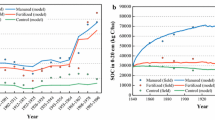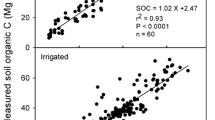Abstract
The EPIC model was used to simulate soil erosion and soil C content at 100 randomly selected sites in the US corn belt. Four management scenarios were run for 100 years: (1) current mix of tillage practices maintained; (2) current trend of conversion to mulch-till and no-till maintained; (3) trend to increased no-till; (4) trend to increased no-till with addition of winter wheat cover crop. As expected, the three alternative scenarios resulted in substantial decreases in soil erosion compared to the current mix of tillage practices. C content of the top 15 cm of soil increased for the alternative scenarios, while remaining approximately constant for the current tillage mix. However, total soil C to a depth of 1 m from the original surface decreased for all scenarios except for the no-till plus winter wheat cover crop scenario. Extrapolated to the entire US corn belt, the model results suggest that, under the current mix of tillage practices, soils used for corn and/or soybean production will lose 3.2 × 106 tons of C per year for the next 100 years. About 21% of this loss will be C transported off-site by soil erosion; an unknown fraction of this C will be released to the atmosphere. For the base trend and increased no-till trend, these soils are projected to lose 2.2 × 106 t-C yr−1 and 1.0 × 106 t-C yr−1, respectively. Under the increased no-till plus cover crop scenario, these soils become a small sink of 0.1 × 106 t-C yr−1. Thus, a shift from current tillage practices to widespread use of no-till plus winter cover could conserve and sequester a total of 3.3 × 106 t-C yr−1 in the soil for the next 100 years.
Similar content being viewed by others
References
CTIC (Conservation Tillage Information Center): 1990,National Survey of Conservation Tillage Practices, Conservation Tillage Information Center, Fort Wayne, IN.
IPCC (Intergovernmental Panel on Climate Change): 1992,Climate Change 1992: The Supplementary Report to the IPCC Scientific Assessment, Cambridge University Press, 200 pp.
Kern, J.S., and Johnson, M.G.: 1993,Soil Sci. Soc. Am. J. 57, 200.
Onstad, C.A. and Foster, G.R.: 1975,Transactions of the ASAE 18, 288.
Phillips, D.L., Hardin, P.D., Benson, V.W., and Baglio, J.V.: 1993,J. of Soil and Water Conservation, in press.
Post, W.M., Peng T.H., Emanuel W.R., King A.W., Dale V.H., and DeAngelis, D.L.: 1990,Amer. Sci. 78, 310.
Robinson, A.R.: 1979, Sediment Yield as a Function of Upstream Erosion, in: Peterson, A.E. and Swan, J.B. (eds),Universal Soil Loss Equation: Past, Present, and Future. Soil Sci. Soc. Am., Madison, WI, pp. 7–16.
Scherte, D.L.: 1988,J. of Soil and Water Conservation 43, 256.
Schlesinger, W.H.: 1985, Changes in Soil Carbon Storage and Associated Properties with Disturbance and Recovery, in: Trabalka, J.R. and Reichle, D.E. (eds),The Changing Carbon Cycle: A Global Analysis, Springer-Verlag, New York, NY, pp. 194–220.
SCS (Soil Conservation Service): 1981,Land Resource Regions and Major Land Resource Areas of the United States, US Department of Agriculture Agricultural Handbook 296, Washington, DC, 156 pp.
SCS (Soil Conservation Service): 1989,Summary Report, 1987 National Resources Inventory, Iowa State University Statistical Laboratory, Statistical Bulletin Number 790, Ames, IA, 37 pp.
Sharpley, A.N. and Williams, J.R. (eds): 1990a,EPIC-Erosion/Productivity Impact Calculator: 1. Model Documentation, US Department of Agriculture Technical Bulletin No. 1768, Washington, DC, 235 pp.
Sharpley, A.N. and Williams, J.R. (eds): 1990b,EPIC--Erosion/Productivity Impact Calculator: 2. User Manual, US Department of Agriculture Technical Bulletin No. 1768, Washington, DC, 127 pp.
Smith, S.J., Sharpley, A.N., and Nicks, A.D.: 1990, Evaluation of EPIC nutrient projections using soil profiles for virgin and cultivated lands of the same soil series, in: Sharpley, A.N. and Williams, J.R. (eds),EPIC--Erosion/Productivity Impact Calculator: 2. Model Documentation, US Department of Agriculture Technical Bulletin No. 1768, Washington, DC, pp. 217–219.
Williams, J.R.: 1975, Sediment yield prediction with Universal Soil Loss Equation using runoff energy factor, in:Present and Prospective Technology for Predicting Sediment Yields and Sources, US Department of Agriculture Agricultural Research Service Report ARS-S-40, Washington, DC, pp. 244–252.
Williams, J.R. and Renard, K.G.: 1985, Assessment of soil erosion and crop productivity with process models (EPIC), in: Follett R.F. and Stewart B.A. (eds),Soil Erosion and Crop Productivity, American Society of Agronomy/Crop Science Society of America/Soil Science Society of America, Madison, WI, pp. 67–103.
Wischmeier, W.H. and Smith, D.D.:1978,Predicting Rainfall Erosion Losses, a Guide to Conservation Planning, US Department of Agriculture Agricultural Handbook No. 537, Washington, DC, 58 pp.
Author information
Authors and Affiliations
Rights and permissions
About this article
Cite this article
Lee, J.J., Phillips, D.L. & Liu, R. The effect of trends in tillage practices on erosion and carbon content of soils in the US corn belt. Water Air Soil Pollut 70, 389–401 (1993). https://doi.org/10.1007/BF01105010
Issue Date:
DOI: https://doi.org/10.1007/BF01105010




